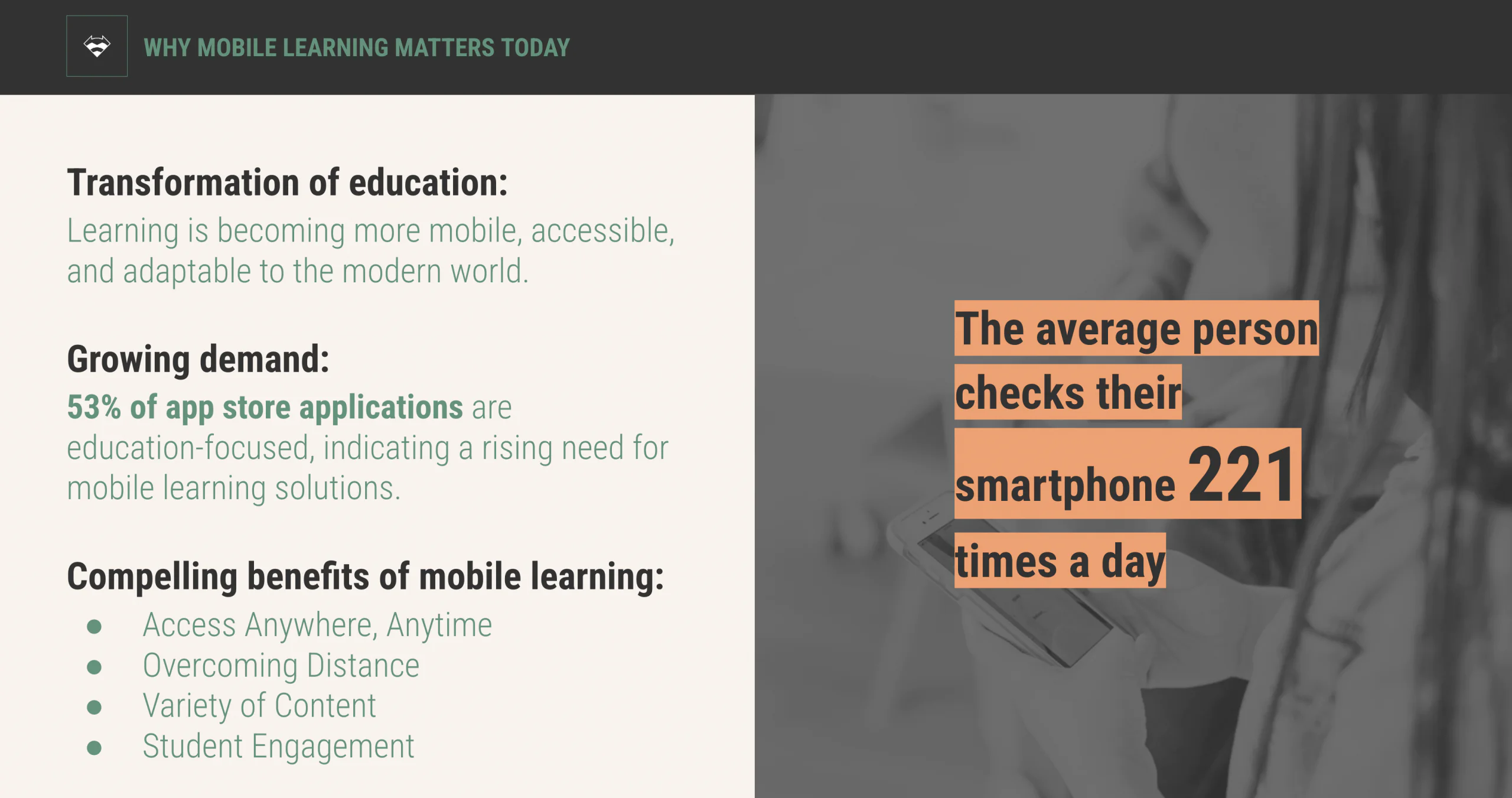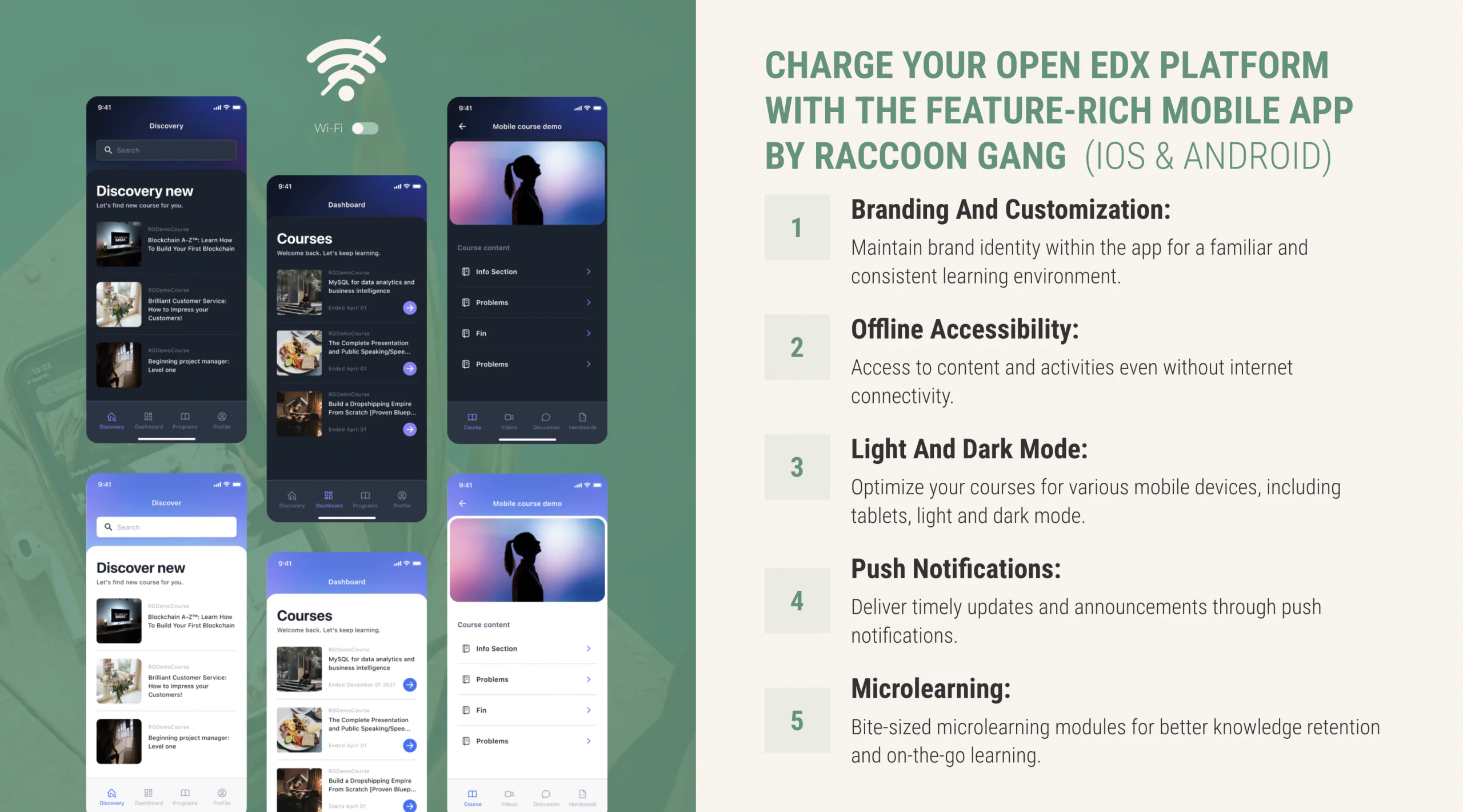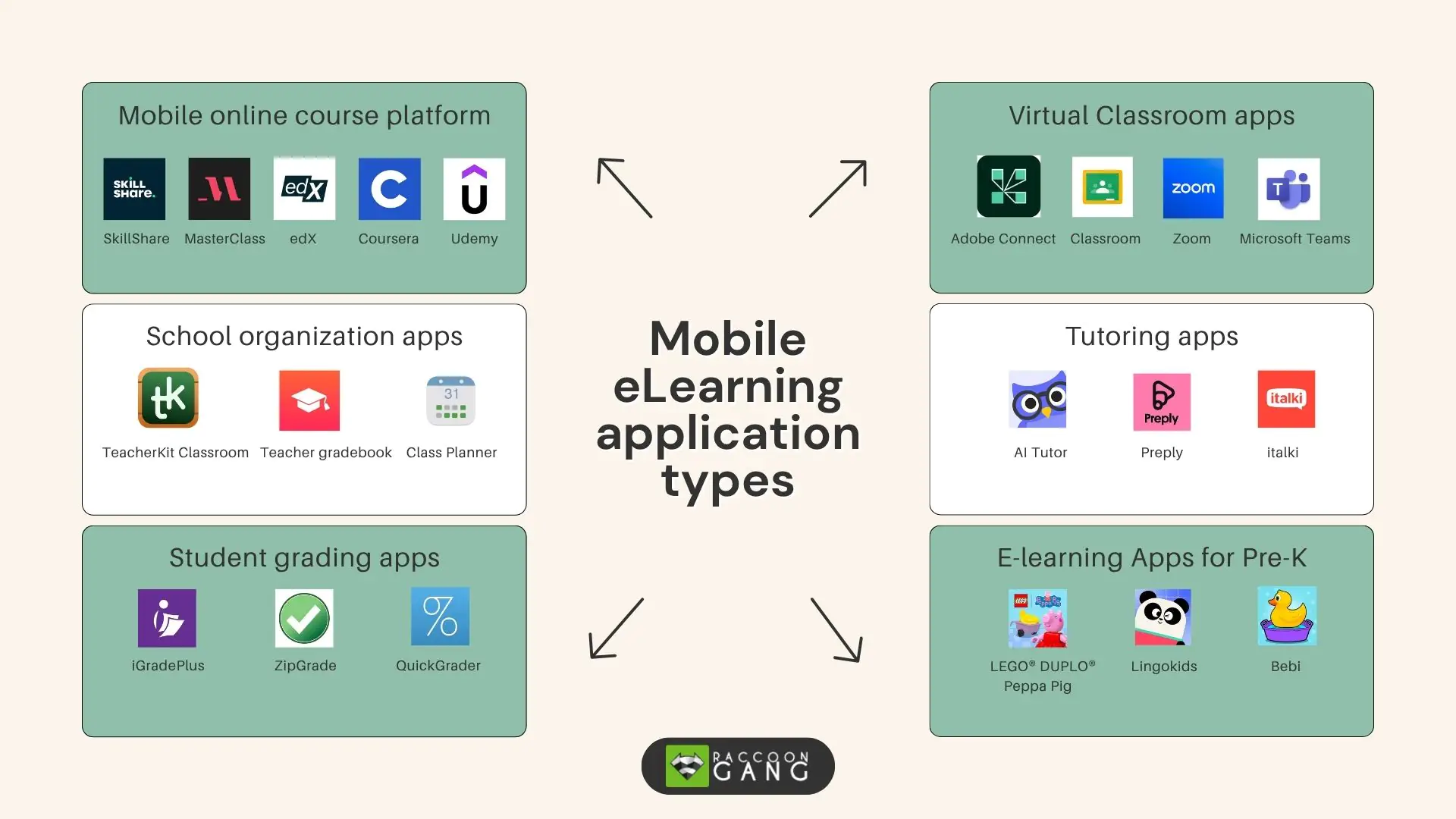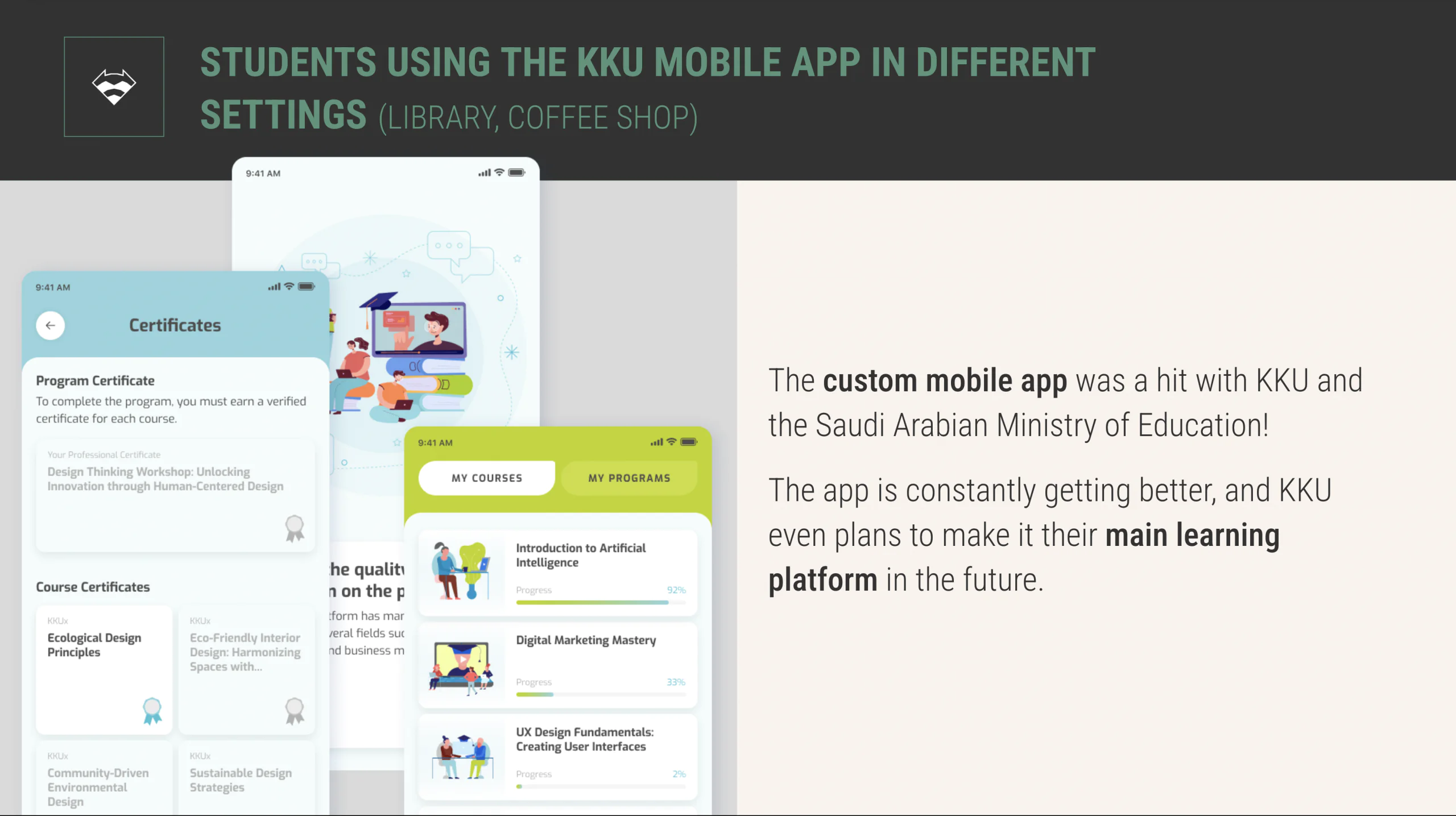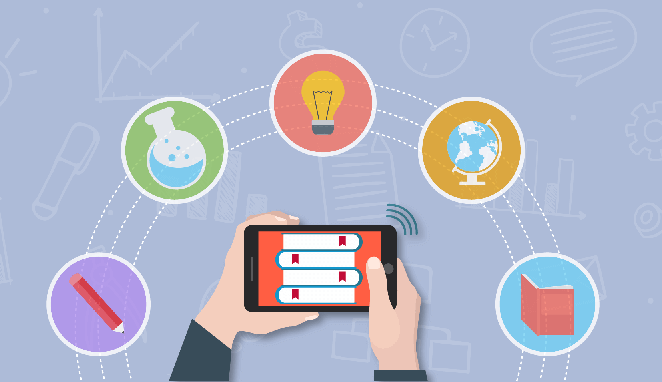Most learners today don’t wait to get to a desk to learn something. They already have everything they need in their pocket. By “everything they need,” we mean, of course, the ubiquitous smartphone. Since mobile devices have become our interactive mobile learning tools, educational institutions and organizations can no longer ignore the shift toward mobile learning. If you’re serious about engaging a wider audience — whether it’s a company training or a course for volunteers — nothing will support your success more than mobile learning.
Mobile learning isn’t optional anymore
When training is tied to desktop-only access, participation drops and learning stalls. Mobile learning today is about accessibility, course delivery, and user engagement. With the right mobile eLearning tools, learning becomes part of daily routines — not something separate from them.
What’s often missed in discussions around mobile learning is its impact on timing. Learners don’t just want flexibility — they need knowledge at the point of need. Whether it’s a quick how-to before a meeting or a refresher after holidays, mobile learning technologies make that possible.
“Done right, mobile-first tools improve knowledge retention by 55% and give teams what they need — when and where they need it. That’s the real value of mobile eLearning solutions: not just portability, but relevance.” — E-learning Delivery Manager at Raccoon Gang
Why Mobile Learning Matters in 2025
The demand for rapid knowledge delivery isn’t just about convenience — it’s a strategic priority. In 2025, businesses face constant change:
- evolving compliance rules
- shifting customer needs
- rapid product updates
Without adaptive training systems, even well-prepared teams fall behind.
That’s where mobile learning software becomes essential for online employee training. It allows organizations to push critical updates and training in real time, directly to the devices employees already use. Instead of waiting for the next scheduled session, learning occurs when it’s needed most (as they say, “here and now”).
Mobile training supports more than flexibility. It enables continuity during disruption, faster scaling during growth, and sharper execution during transitions. That makes it a core asset, not a side feature.
And for educational institutions, the case is even more compelling. Microlearning, gamified quizzes, video content, and the previously mentioned push notifications all support your educational goals. After all, every student carries a smartphone in their pocket, meaning they can always have access to the specific part of the learning material that’s both useful and engaging to them.
Top Mobile eLearning Tools to Use in 2025
When we talk about mobile eLearning, we talk about the countless benefits associated with this learning approach. But we also want to emphasize once again that mLearning is not just eLearning on a mobile device.
mLearning is a full-fledged category. Benefits such as flexibility, responsiveness, bite-sized learning, on-the-go access, and instant push notifications make a smartphone a serious learning assistant.
This list of mobile learning benefits could go on, but the key point is the growing adoption of mobile learning platforms, mobile LMSs, and learning apps, all of which are transforming how education and training are delivered.
“The vast majority of students (80%) connect two or more devices (commonly a smartphone and laptop) to campus Wi-Fi every day.”
So, what do you need to create an interactive mobile learning experience? The answer lies in selecting the top mobile learning tools. Let’s take a look at some of the most interesting ones:
Claro
Short Description: A mobile-friendly HTML5 authoring tool with strong design and collaboration features.
Key Features:
- HTML5 course creation
- Real-time collaboration
- Adaptive and responsive outputs
- Pre-built mobile themes and assessments
Benefits: Helps teams create reusable, responsive content quickly. Ideal for organizations needing consistent design across platforms.
Articulate Storyline
Short Description: A leading e-learning authoring tool for interactive course development on desktop and mobile.
Key Features:
- HTML5 and native app publishing
- Slide layers, triggers, and characters
- Touch gesture support
Benefits: Great for teams that want to create immersive courses without a steep learning curve. Works well for both beginners and experienced developers.
iSpring Suite
Short Description: A PowerPoint-based tool for converting presentations into mobile-ready courses.
Key Features:
- Supports HTML5, .exe, and web publishing
- Offline mobile access
- Interactive quizzes and role-plays
Benefits: Perfect for educators and trainers converting existing materials into mobile content. Saves time and works across all devices.
SumTotal ToolBook
Short Description: A mature tool offering template-driven mobile course creation with geo-location support.
Key Features:
- Drag-and-drop on iOS devices
- Templates for compliance and soft skills
- Mobile browser compatibility
Benefits: Trusted by enterprises for compliance and corporate training. Well-suited for highly structured, role-specific learning.
Lectora
Short Description: A powerful mobile authoring tool supporting responsive course design.
Key Features:
- RCD (Responsive Course Design)
- HTML5 and native app publishing
- ReviewLink feedback integration
Benefits: Great for converting text-heavy courses into mobile-friendly content. Works well for educational institutions and corporate learning teams.
Adobe Captivate
Short Description: An advanced tool for building mobile-first interactive courses with responsive design.
Key Features:
- Fluid Boxes for auto-alignment
- LMS integration and HTML5 animation
- Convert desktop to mobile courses
Benefits: Ideal for teams with existing Adobe experience. Cuts content creation time while supporting cross-device learning.
TalentLMS (Mobile LMS)
Short Description: A cloud LMS with strong mobile learning apps and easy authoring.
Key Features:
- Native apps for iOS and Android
- Offline learning support
- Built-in quiz and survey tools
Benefits: Scalable for small to medium businesses. Easy to roll out mobile training programs across teams.
LearnWorlds (Mobile eLearning Platform)
Short Description: A platform for building and selling mobile courses with custom branding.
Key Features:
- Branded Custom Mobile App option
- Interactive video and ebook support
- Gamification and assessments
Benefits: Great for course creators and institutions looking to monetize learning content on mobile.
Moodle App
Short Description: The official mobile app for the popular open-source learning management system.
Key Features:
- Offline course access
- Push notifications
- Seamless sync with Moodle LMS
Benefits: An accessible solution for schools and universities already using Moodle. Supports adaptive learning on the go.
Open edX® Mobile App (by Raccoon Gang)
Short Description: A fully custom Open edX mobile app tailored to specific user needs and platform design.
Key Features:
- Multi-language support
- Deep LMS integration
- RTL and accessibility features
- Offline access
- Notifications
- E-commerce integration
- Native programs
Benefits: Built for institutions needing branded, scalable mobile apps for complex eLearning environments. Supported by Raccoon Gang’s development team.
How to Choose the Right Mobile Learning Platform
Not all mobile training apps and mobile learning platforms are built the same. When evaluating options, focus on the features that directly impact your learners’ experience and your ability to scale.
What to Look for in Mobile Training Apps and Solutions
| Criteria | Why It Matters | What to Look For |
| UX/UI Design | A poor interface leads to low engagement and high drop-off rates. | Clean layout, intuitive navigation, mobile-first design, and responsive learning support. |
| Offline Access | Learners need to access content regardless of connectivity. | Downloadable modules, offline quizzes, and automatic sync when reconnected. |
| Scalability | Your platform should grow with your user base without performance issues. | Cloud-based architecture, support for thousands of users, multi-device compatibility. |
| Analytics | Data helps improve content and track training outcomes. | Real-time reports, learner progress tracking, course completion stats. |
| Integrations | Seamless workflows depend on system compatibility. | Support for your LMS, CRM, HR systems, and third-party mobile learning solutions. |
Choosing the right platform isn’t just about screen recording features or something — it’s about aligning with your long-term training goals and delivering value across all devices.
Case Studies: Mobile Learning with Open edX
Let’s take a trip to Saudi Arabia and meet King Khalid University (KKU), one of the largest public universities in the region. KKU serves over 60,000 students with future-ready courses and welcomes more than 2.5 million visitors to its online learning platform each month. With numbers like these, they knew accessibility couldn’t stop at the desktop.
KKU discovered that 80% of their learners were studying through phones or tablets. To meet this need, they partnered with Raccoon Gang to develop a custom Open edX mobile app. The goal was to recreate their full-featured platform as a seamless mobile experience.
The Result? A culturally responsive mobile training app with full Arabic support and right-to-left orientation.
This app wasn’t a one-size-fits-all solution. It was a Custom Mobile App tailored to match the platform’s advanced learning tools and offer a mobile-first experience without compromising features.
Future Trends in Mobile Learning
The future of mobile learning is not just about remote learning. It’s about rethinking how people learn in real-world environments. It will look like less structure, more context, and tighter alignment between learning and doing.
Here’s how emerging mobile eLearning solutions are moving beyond trends:
AI Will Turn Mobile Learning Into a Smart Advisor
AI won’t just personalize content — it will predict learning needs before learners ask. Imagine a mobile training app that notifies a field technician about a short refresher right before they service unfamiliar equipment, based on their location, performance history, and previous gaps.
What to expect: AI-driven personalization will lead to real-time, adaptive guidance embedded in work.
Microlearning Will Become Task-Based, Not Just Time-Based
Today’s microlearning means “short and focused.” Tomorrow’s microlearning will mean task-aligned. Mobile content will break down into modules triggered by specific moments — pre-shift, post-meeting, during wait time.
What to expect: Courses will adapt to role, location, or even calendar integration, not just device size.
Gamification Will Drive Behavior Change, Not Just Engagement
Expect a shift from simple badges to behavior-driven mechanics. For example, mobile platforms may reward peer collaboration, coaching others, or solving real problems within the app.
What to expect: Gamification will push learning into real-life outcomes — measuring action taken, not just clicks.
AR/VR Will Bring “Learning by Doing” to Everyone
Mobile-accessible AR and VR will make hands-on training possible for teams that can’t access labs or on-site mentoring. Think: nurses practicing procedures in AR before entering a clinic, or warehouse workers scanning a shelf to trigger safety guidance through their camera view.
What to expect: These aren’t prototypes anymore—they’re becoming budget-friendly and scalable.
Conclusion (What does all this mean for your organization?)
Mobile learning software won’t replace your LMS. But mobile e-learning tools will become the first point of access for most learners. Organizations that treat corporate mobile learning as a full training environment will be the ones building smarter, faster, and more agile workforces.
And what will mobile learning bring to educational institutions?
It will open access to underserved students, support flexible learning paths, and increase completion rates through better engagement. When every student can carry lessons in their pocket, education becomes more personal, more continuous, and less dependent on place or schedule.
Mobile is not just a format. It’s a mindset — one that puts the learner’s reality at the center of design.
The future of mobile learning is real-time, real-world, and responsive. Are you ready for it?
→ Book a free consultation and let’s build a mobile learning strategy that actually works for your learners.

